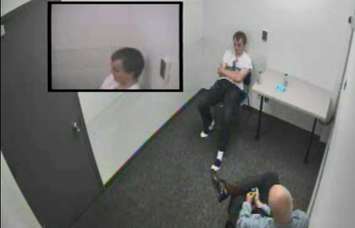The Crown concluded its closing arguments in the Nathaniel Veltman murder trial Wednesday morning.
Veltman is charged with four counts of terrorism-motivated first-degree murder and one count of terrorism-motivated attempted murder after his pick-up truck was steered into five members of the Afzaal family on June 6, 2021.
Talat Afzaal, 74, her son Salman Afzaal, 46, his wife Madiha Salman, 44, and their daughter Yumnah, 15, were all killed. Salman and Madiha's son, who was nine at the time, was the only survivor.
Justice Renee Pomerance began the day with an instruction for the jury about the language used by Crown attorney Fraser Ball in the beginning of his closing statements.
"I'm going to tell you, in no uncertain terms to disregard the emotional content and gratuitous language used by Crown counsel," Pomerance said. She also reminded them of the oath they took to decide the case without emotion, prejudice, or bias.
Ball resumed his closing address by telling the jury that Veltman's murder of the Afzaal family was deliberately planned and a "brutal message meant for the whole world."
He said that Veltman spent months planning his attack. Adding that the content Veltman was consuming online was highly racialized and that "he made the choice" to shift his energies and channel his rage away from "suicidal to homicidal."
Ball said that in his planning, Veltman carefully covered his tracks, as proven by the testimony provided by the Crown's digital forensic expert. "He showed discipline in keeping his own secrets," he said.
"Mr. Veltman started planning his attack and for that he needed tools," Ball continued. He reminded the jury that Veltman purchased a truck, grill guard, bulletproof vest, and army helmet. He reiterated that those purchases were part of the plan.
"He needed the truck to increase the chances that his ultimate targets would die. He needed the armour to ensure he would survive," Ball said.
The Crown then reminded the jury again how careful Veltman was about privacy and advised that his Manifesto "A White Awakening" had been saved twice, without password protection, and left out in plain view for police to find.
"He wanted it to be found," Ball said.
Ball continued to speak about the deliberate actions Veltman had taken, mentioning the weapons in Veltman's truck and the crusader t-shirt he put on before the attack. "Mr. Veltman had it planned down to his undershirt," he said.
Ball described the attack on the Afzaal family as very public murders. "It was not discrete and that was the point. You do not whisper a brutal message. You shout it," he declared.
Ball advised the jury that those were all examples of intention and planning, which means Veltman should be found guilty of first-degree murder, but he added that if they didn't find that sufficient, terrorism is another way to convict someone of first-degree murder.
"The Afzaal's were the just the medium," Ball said. "The brutal message was for a much bigger audience."
The Crown reminded the jury of Veltman's statements to police when he said he wanted to become an inspiration to other white nationalists.
"Brenton Tarrant was stretching forward with a terrorist baton, Mr. Veltman was reaching back to grab it," Ball said.
He said Veltman also wanted to send a message to Muslim people, saying that he wanted them to fear for their lives, to "not know if the next person driving could be a white nationalist." He wanted them "to be terrified," Ball said "and that is terrorism."
Ball also mentioned Veltman's religious and ideological reasons for his attack.
"In murdering the Afzaals Mr. Veltman had a broader target in mind. All Muslims," Ball concluded.
The jury was then dismissed so the judge and lawyers could have discussions before Justice Pomerance's final instructions.
Shortly after 1:30 p.m. the jury returned to the courtroom, where Justice Pomerance began her charge.
She first reminded them "I am the judge of the law and you are the judge of the facts," adding that the jury needs to consider her instructions and the entire trial as a whole.
She then cautioned them about recognizing unconscious bias and setting aside emotions when they make their decision. "We must remember that Mr. Veltman is not on trial for his beliefs, he is on trial for his actions," Pomerance said.
She then reminded the jury that they "must give the benefit of the doubt to Nathaniel Veltman."
Pomerance went on to explain differences in credibility vs reliability of witnesses, direct vs indirect evidence, and what statements made by Veltman outside of court are admissible for their truth. She said that any statements made by Veltman, except for the ones he made to Dr. Gojer, may be considered and weighed by the jury in their decision.
She also told the jury that they should not concern themselves with the penalties that will result from their decision, as that burden falls to her.
When going through the evidence presented during the trial Pomerance told the jury that they have access to all of it, from agreed upon statements of fact to transcripts to videos and photographs.
She then had Veltman's manifesto entered into the record as exhibit #32. The Crown read excerpts of the manifesto earlier in the trial, but it was never included as an exhibit. It can now go into the jury room during deliberations with the other evidence.
Pomerance reminded the jury multiple times that they can believe "all, some, or none" of the evidence or testimony put in front of them, they also get to decide how much weight to give that evidence in their final decision.
After a break, Pomerance reminded the jury of the offences. She said that there's no dispute about the fact that Veltman drove his vehicle into the Afzaal family, killing four and seriously injuring one. What is in dispute is Veltman's state of mind when the attack happened.
Pomerance explained that the jurors must decide whether the Crown proved beyond reasonable doubt:
if his actions are an unlawful act
if his actions caused a death
if he had intention to kill
if the murders were planned and deliberate or a terrorist act
"The Crown says that these were intentional killings that Mr. Veltman had been planning for months," she said. Pomerance noted that the Crown considers these first degree murders, not only because he planned them, but because it was terrorist activity.
She added that only one of those reasons must have been proved beyond a reasonable doubt to the juror for them to find Veltman guilty of first-degree murder and that they don't all have to agree on which it was.
The defence believes Veltman is guilty only of manslaughter, an act that results in death but is not the intent of the person.
"The defense says that the Crown has not proved murder, first-degree murder, or attempted murder beyond a reasonable doubt," Pomerance said. She reminded the jury of Veltman's background, mental health issues, and his use of psilocybin (magic mushrooms). Adding that the defence's position is that Veltman did not plan the murders and the Crown didn't prove that he did beyond a reasonable doubt.
The judge then summarized the facts of the case, presented to the jury over the last 10 weeks.
Pomerance reminded the jury when she spoke about forensic psychiatrist Dr. Julien Gojer's evidence that he determined Veltman could not be found "not criminally responsible (NCR) by way of mental illness."
Ultimately, Pomerance said, the jury must decide whether Veltman had the intent to kill the Afzaal family and if he could foresee the consequences of his actions. If they have reasonable doubt, they must find Veltman not guilty of murder. He would therefore be convicted of manslaughter.
After an afternoon break, Pomerance gave the definitions of first and second degree murder that the jury must consider when they make their decision.
She explained that to find Veltman guilty of first degree murder they must find that the killing was "planned and deliberate," which is different than him having the thought or intention of doing something.
Another path to find Veltman guilty of first degree murder involves terrorist activity. She added that Veltman is not being prosecuted for his beliefs, but beliefs can lead to terrorist activity.
The jury was told that terrorist activity is defined in the criminal code if three criteria are met:
act requirement - if a person or group commits an act that causes death to a person by way of violence
motive requirement - if the act was committed in part or whole for political, religious, or ideological cause
ulterior intention requirement - if the act is committed in part or whole with the intention to intimidate a segment of the public (inside or outside of Canada) with regard to their security
The judge then handed out two decision trees to the jury, one that deals with first degree murder and a second that deals with attempted murder. It has already been decided that because the four deaths in the case were caused by the same action if they find Veltman guilty of the murder of one person it also applies to the other murder charges.
Pomerance then turned to the charge of attempted murder. She told the jury that in order to find Veltman guilty of the attempted murder of a then 9-year-old boy they must be satisfied beyond a reasonable doubt that he intended to kill the child. If they aren't satisfied that the Crown proved attempted murder they will instead find Veltman guilty of aggravated assault.
At the end of her charge, Pomerance reminded the jury they must be unanimous in whatever verdict they come to.
Following that, the court had to discharge one member of the jury as only 12 are required by law to deliberate a verdict. The registrar drew a card at random causing juror #4 to be dismissed.
The fate of Nathaniel Veltman now rests with the remaining members of the jury.






